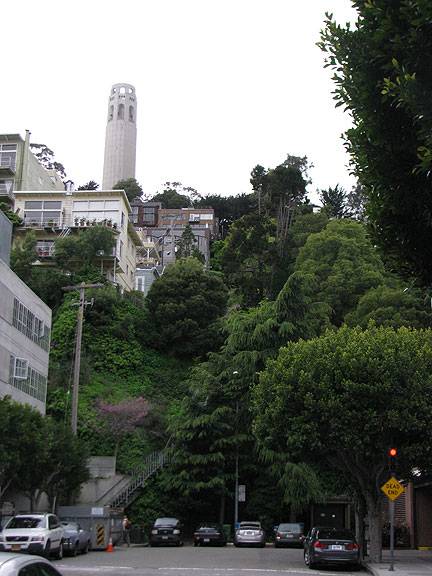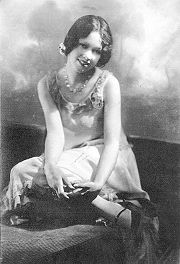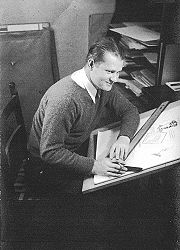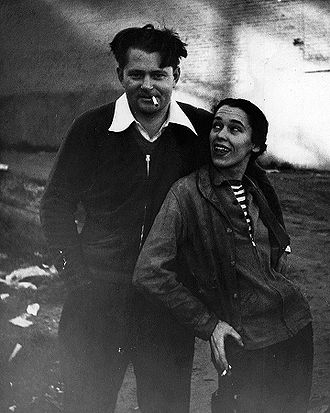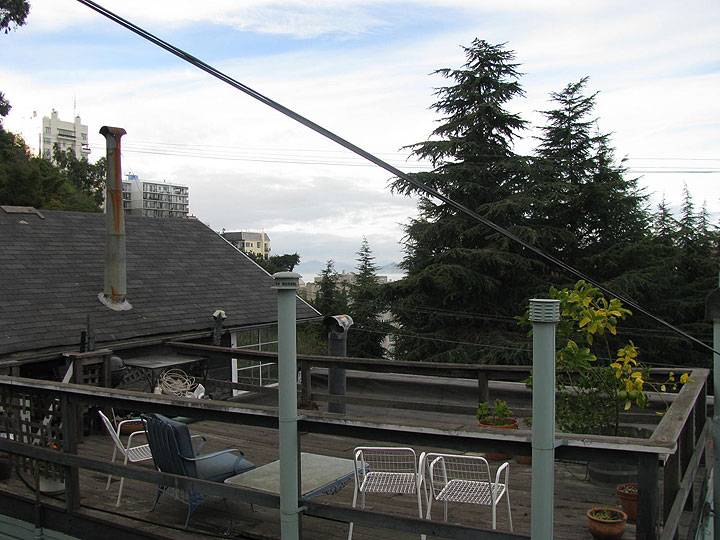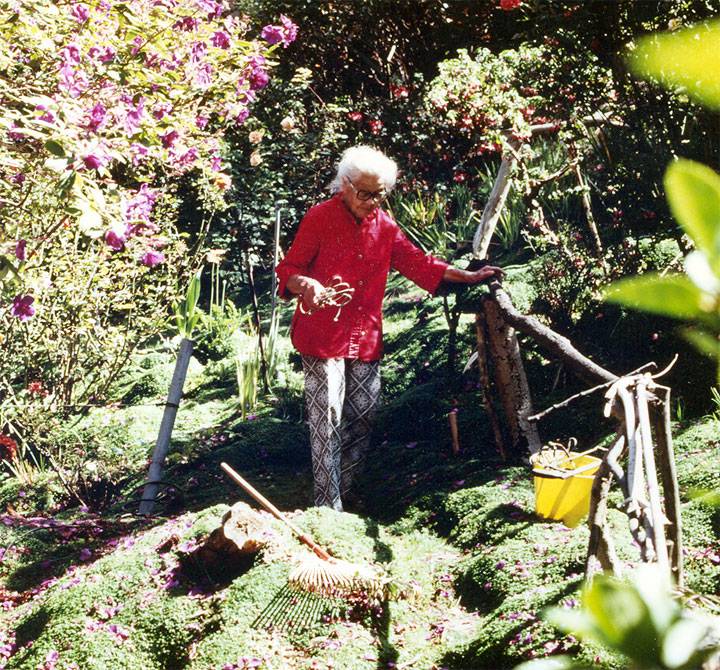Greenwich Steps: Difference between revisions
(added to navigation loop) |
m (moved byline up to under "Historical Essay") |
||
| Line 1: | Line 1: | ||
'''<font face = Papyrus> <font color = maroon> <font size = 4>Historical Essay</font></font> </font>''' | '''<font face = Papyrus> <font color = maroon> <font size = 4>Historical Essay</font></font> </font>''' | ||
''This article was originally serialized over three issues in ''[http://www.thd.org The Semaphore]'' #195, 197, and 198 in 2011 and 2012. | ''by Mark Bittner, This article was originally serialized over three issues in ''[http://www.thd.org The Semaphore]'' #195, 197, and 198 in 2011 and 2012.'' | ||
''Anyone who has been around Telegraph Hill for any length of time knows about Grace Marchant and her garden on the [[Filbert Steps and Grace Marchant Gardens|Filbert Steps]]. Less well known is the contribution of Grace’s daughter, Valetta Heslet, and her husband Desmond, the forces behind the garden on the Greenwich Steps. This account was omitted from Mark Bittner’s book'' “The Wild Parrots of Telegraph Hill.” | ''Anyone who has been around Telegraph Hill for any length of time knows about Grace Marchant and her garden on the [[Filbert Steps and Grace Marchant Gardens|Filbert Steps]]. Less well known is the contribution of Grace’s daughter, Valetta Heslet, and her husband Desmond, the forces behind the garden on the Greenwich Steps. This account was omitted from Mark Bittner’s book'' “The Wild Parrots of Telegraph Hill.” | ||
Revision as of 00:14, 5 May 2013
Historical Essay
by Mark Bittner, This article was originally serialized over three issues in The Semaphore #195, 197, and 198 in 2011 and 2012.
Anyone who has been around Telegraph Hill for any length of time knows about Grace Marchant and her garden on the Filbert Steps. Less well known is the contribution of Grace’s daughter, Valetta Heslet, and her husband Desmond, the forces behind the garden on the Greenwich Steps. This account was omitted from Mark Bittner’s book “The Wild Parrots of Telegraph Hill.”
The Greenwich Steps from Battery Street looking up at Coit Tower on the top of Telegraph Hill.
Photo: Chris Carlsson
In 1912, Grace Merchant, 26, and her 3-year-old daughter Valetta, boarded a train in Mellette County, S.D., for Los Angeles. Grace was a farmer’s daughter and had married a farmer, but she was bored with rural life and hoping to get a new start in show business. Not long after she arrived in California, Grace found work with Mack Sennett, the creator of the “Keystone Kops.” Grace Merchant then became Grace Marchant, bathing beauty and stunt woman, whose specialty stunt was diving off ocean liners.
Grace’s career was not very successful, but she had plans for her daughter Valetta, who was studying dance and piano at an early age. While still in her teens, Valetta began working as a chorus girl, first for RKO Studios, then for Paramount. She was in the chorus line of several Hollywood musicals, and spent much of her youth traveling in trains and dancing in theaters across the country. Grace had quit her other jobs and become the seamstress for Valetta’s dance troupe. Valetta was a somewhat frail girl, and the touring eventually took its toll on her. She was desperate to stop touring, but Grace pushed Valetta to keep working. They argued about it constantly.
One day in the early 1930s in a theatre in Los Angeles, Desmond Heslet was standing at the top of a ladder hanging some posters he’d designed. As he worked, a dance troupe rehearsed below. He paused to watch, and one of the girls caught his eye. Desmond said it was love at first sight. He climbed down the ladder, waited for a break in the rehearsal, then struck up a conversation with the dancer. Valetta was so exhausted that she felt ill. Unable to conceal her condition, she explained everything to Desmond, who decided that he was going to rescue this “little waif of a dancer.”
Desmond’s childhood had been as unique as Valetta’s. Born in Los Angeles, he’d spent much of his youth in Copper Canyon, Mexico, where his father managed a silver mine. Many of the workers were Yaqui Indians, and Desmond spent a lot of time in their presence. The Heslets had a famous acquaintance, who was also an occasional dinner guest, Pancho Villa. The relationship began one day when Villa and his men were seen riding toward the village where the Heslets lived. All their neighbors were alarmed, but Desmond’s mother responded to the news by calmly preparing dinner for Villa and his men.
Because she welcomed him fearlessly, Villa took a liking to her and her family.
He protected them — he’s said to have executed one of his men for stealing a Heslet horse — and he rewarded her for the dinners with gold coins. In later years, Desmond often displayed a rifle that he claimed had once belonged to Villa.
Desmond’s courtship of Valetta went well, and they were soon married. To get Valetta away from Grace, Desmond took her north to San Francisco. It was the time of the Great Depression, and he’d heard that the city was a good place to find work. A commercial artist, Desmond worked for the telephone company briefly, then found a job in the art department at the San Francisco Examiner. His primary task was the creation of fanciful drawings of California living that were used to advertise the state on the East Coast.
Coit Tower soon after its construction in the mid-1930s.
Photo: The Semaphore
When Desmond and Valetta arrived in San Francisco, they found a place in the Marina district, at the shore of San Francisco Bay. Valetta hated the constant ocean winds, so in 1932 or ‘33 the Heslets moved to an apartment on Montgomery Street on Telegraph Hill’s protected east side. Shortly after moving in, Valetta went out to explore her new neighborhood. Just down the block she discovered a long staircase, Greenwich, and decided to see where it led. One-hundred steps down, the concrete ended and Greenwich became a dirt path. She turned a corner and found herself within a remnant of the old working-class slum that had once covered the hillside. On the north side of Greenwich was the lip of an old quarry, on the south side, a line of old shacks. The land was mostly sand and rock. Other than a few trees, the only things growing were grasses and weeds. Goat trails ran off in every direction and the ground was littered with bits of trash. The neighborhood did have one redeeming quality: a spectacular view of the bay. Valetta was fascinated by the neighborhood and continued to explore. One of the old cottages caught her fancy, and when she learned that it was for sale, she went home and begged Desmond to buy it for her. He agreed to.
There is a wonderful photograph of Desmond and Valetta that was taken on the Greenwich Steps at around the time they moved in to their new home. Desmond was in his early 30s and Valetta was in her mid-20s. Desmond evokes Jack London or a young Ernest Hemingway. Dressed somewhat shabbily in a dark sweater, a large-collared shirt and dark pants, he’s burly, strong and unkempt. His hair is thick and shaggy, and a cigarette hangs from his lips. He has a round face, he’s smiling, but the look in his eye is slightly caustic. His left arm is draped around Valetta, who, lithe and small, leans against him, her back against his ribs. Her head is turned to one side, and she’s looking up at Desmond with an open-mouthed, admiring smile. She has a dramatic beauty — high cheekbones, dark and arched eye brows, dark lips. Her left hand is placed jauntily on her hip and holds a cigarette that looks handmade. She’s wearing a suede jacket and a shirt with dark and light horizontal stripes. It’s a type of shirt — like a French sailor shirt — that I associate with a certain strain of Bohemian. In fact, they both look like the prototypical Bohemians.
When Desmond rescued Valetta from Grace, he didn’t know that although the two women fought constantly, they’d been a team since leaving South Dakota, and they were inseparable. Grace followed Valetta to San Francisco and moved in with her daughter and son-in-law. Desmond often spoke as if he detested Grace. He had a running joke that the title of his autobiography would be “Me, My Wife and My Goddamn Mother-in-Law.” In the beginning, he probably did dislike her, but later his dislike seemed more an act than real. Desmond adored Valetta, but he couldn’t have her without Grace. He obviously accepted the situation, because for the rest of her long life, Grace never really left.
Next-door to the Heslets’ new home was a compound of old shacks. The property looked something like a child’s set of wooden blocks: The buildings sat next to and on top of each other in a seemingly haphazard way. It was a maze that you could get lost in. Everything was dilapidated. None of the buildings had foundations; outhouses were the norm. There was one long barrack-like structure, but all the others were cabins that had been subdivided. There was room for a bed and a dresser, but little more. The units were so small that Desmond referred to them as “stalls.” He said it was Grace who came up with the idea that the three of them should lease the Compound and run it themselves. The owner, a Mr. Meyer, went along with the idea on the condition that they not kick out any of his tenants, who were all single workingmen.
Meyer ended up selling the property to the Heslets, who began a major rebuilding project with Desmond supplying the money and Valetta and Grace the labor. Whenever side-by-side units became vacant, they’d enlarge them by tearing out the dividing wall. They installed toilets, windows and new wiring. Because their own cottage was too ramshackle to be saved, Desmond, Valetta and Grace moved into the Compound and started scavenging pieces of their old home. Grace found a source of bricks and became obsessed with building fireplaces, putting them wherever she could fit one. To give the Compound an identity, they painted the buildings black with white trim. All the renovations were improvised, based on whatever materials they had at hand. They did them without bothering to get permits, which was an old tradition on Telegraph Hill. The buildings they were fixing up had been constructed by the same methods. Desmond called it “bootleg architecture.” Even with the improvements, conditions remained primitive. They didn’t see the need for luxuries, and referred derisively to people who wanted them as “steamheaters.”
The Compound in 2012, lower middle of image, cluster of cottage-like dwellings.
Photo: Chris Carlsson
In Telegraph Hill’s history, there had already been two properties called “The Compound.” In both cases, the tenants had been primarily Bohemian. (Bohemian means different things to different people. I use it to mean someone with intellectual or artistic inclinations, who prefers living an interesting life to pursuing money.) The Heslet property became the third Compound. The Heslets were 1930s Bohemians. It was the Great Depression and people at the fringe often had Marxist or anarchist tendencies. Despite having been crushed by the government, the Industrial Workers of the World (the IWW, or the “Wobblies”) was still a strong influence within Bohemian and intellectual circles on the West Coast. But the Heslets weren’t that extreme. They and their tenants were primarily Roosevelt Democrats and vocal in their contempt for Republicans. Desmond and Valetta rented to different types, but most tenants gravitated toward show business or the arts. There were seven buildings in the Compound, and although individual units were not as small as before, most of the buildings contained more than one apartment. There were at least 18 living spaces, and the various locations gradually acquired names: the Cave of the Winds, the Fishbowl, the Bypass, Catfish Row, the Rabbit Hutch, the Mole Hole, the Cavern, the Penthouse, the Outpost and Rotten Row. Tenants called themselves Compounders. They had a wide range of interests and skills, and taught each other. Desmond once wrote that in the Compound one could learn music, drama, art, folk and tap dancing, masonry, plumbing, dead Indian languages, math, cooking and gardening.
Valetta especially liked taking up new studies. When two musicians moved in next-door, she renewed her interest in the piano. Music always played an important role at the Compound. She had two pianos — one, a Steinway baby grand, which must have required a Herculean effort to haul down the Greenwich Steps. The Compound gained a reputation among touring classical musicians as a friendly outpost and some gave private performances there. One tenant was a pupil of composer Darius Milhaud. Valetta learned leather tooling and folk dancing from two of her tenants. She studied mathematics with another, anthropologist and linguist Jaime de Angulo, who, at the time, was royalty within Bohemian circles. Not one to be left out, Grace learned to make pottery and jewelry. Desmond painted and sketched. The Compound threw a lot of parties, but they were much different than the parties people go to nowadays. Instead of sitting around eating, drinking and making small talk, the Compounders staged their own plays and threw dances. More people took the time to learn to play an instrument back then, so whenever music was needed at a party, the Compounders played it themselves. There were wild parties with people roaming from apartment to apartment and drinking into the wee hours.
Valetta occasionally put out a mimeographed newsletter for current and former Compounders. Reading it, you see that they were in each other’s lives constantly. There was always someone to talk to you and you didn’t have to call first; you could just drop in. It wasn’t a big deal when one Compounder walked in on another’s dinner party and asked to use the bathtub. They celebrated holidays and birthdays together, told stories and became friends. All of this existed because the Heslets didn’t care about money. I don’t think they were doctrinaire non-materialists; they simply didn’t see money as something important. You made the minimum you needed to be able to spend time doing what you loved. Rents were low and the Heslets were reluctant to raise them. Some Compounders, when they could afford to, took it upon themselves to raise their own. Rooms almost became the possession of those who lived in them. In one case, a woman moved away, leaving her place to a friend. Later, when the friend moved and someone else wanted to rent it, Valetta felt obliged to check with the original tenant to make sure it was OK with her. She’d been gone for 15 years.
Northerly view from The Compound with one of its decks in foreground.
Photo: Chris Carlsson
World War II brought an end to the party. Most of the men entered the military. Desmond became a cartographer in the Army and was stationed in Oregon and then in Guam. Valetta and Grace both worked in the Marin shipyards, Valetta as a welder and Grace was a riveter. Throughout the war, the Compound housed military personnel, one of whom was Byron White, who later become a U.S. Supreme Court justice. Once the war was over, and not having any of their old tenants to displace, Desmond and Valetta made changes to the largest of the seven buildings, the one called Rotten Row. Originally a three-room barrack-like structure, they tore out walls, added one entire new room, and added onto another. This was to be their home for the rest of their lives. Their lifestyle changed. They were older now and not so wild. They still hosted music concerts, but the focus of the Compound changed. A new project got under way — one that would ultimately bring the parrots to the hill.
In 1948, at age sixty-three, Grace Marchant moved into an apartment on the Filbert Steps, one block south of and parallel to the Greenwich Steps. Filbert and Greenwich are similar in character. Both are lined with old cottages, and both are at the edge of an old quarry. Like Greenwich, much of the land adjacent to the Filbert Steps was too steep or unstable to build on and covered with weeds and garbage. Grace had ideas for the land, and after getting permission from the city—it was officially part of the public right-of-way—she cleared away the garbage and weeds, and started a garden.
Grace Marchant in her garden, 1970s.
Photo: Larry Habegger
While Grace worked on her Filbert Steps garden, Valetta began an identical project on Greenwich. She began by planting the lot that the Heslets’ original cottage had stood on. This was my favorite of all the gardens. It’s the lot in which I found Mandela clinging to an iris after getting winged by the cat. Through the lot ran a narrow brick pathway with a beautiful handrail cobbled together out of old fuchsia and cherry tree branches. The path was lined with grape hyacinth and iris. The entire lot was carpeted with baby’s tears, a thick, lush creeping plant of tiny round leaves. Wisteria climbed the wall of a cabin on the lot’s east side, and along the lot’s western edge, next to my old studio, there was fuchsia. The garden was shaded by princess flower, a small tree with royal purple blossoms, and the exotic-looking datura. Datura, also called Gabriel’s or Angel’s trumpet, is a tall shrub with large green leaves and yellow, white, or pink flowers shaped like long bells. Datura looks like plant life on Venus as depicted in old science fiction movies. Like the parrots, it comes from Peru.
Desmond said there was no plan, that it all happened gradually, but once Valetta had planted the vacant land in the Compound, she started working on the steep, barren slope on the north side of Greenwich. Just as the city had given Grace permission to garden the public right-of-way along the Filbert Steps, it allowed Valetta to work the land next to the Greenwich Steps. The city even provided free water. Her main work area was on a slope that extended out fifty feet as it dropped down around twenty. At the bottom of the slope was a narrow flat area and a fence, which ran the length of an almost sheer cliff. The soil was so poor that for decades Valetta carried bags of dirt up the 98 steps to her garden. The years of quarrying had left the slope unstable, so Valetta hired Greer Jackson, a city bus driver, to come in on his off-hours and terrace the garden with bulk heads. He fashioned hand holds out of old pipes so she could get up and down the slope more easily, and set up an elaborate network of hoses.
At its peak the garden was around 150 feet long and 50 feet wide. The basic scheme was the same as her Compound garden: a ground cover of baby tears, with fuchsia, datura, and princess flower. At the top along the railing, she planted roses. Over time, she mixed in a lot of other plants: iris, foxglove, montbretia, forget-me-nots, nasturtium, ginger, calla lily, hydrangea, mallow, impatiens, and Pride of Madeira. Her garden was never dainty; it was lush like a jungle. One reason for the variety was that Valetta and Grace couldn’t afford to buy plants of their choosing; they had to filch them wherever they could. Their primary source was Golden Gate Park, which they raided surreptitiously for slips. The area Valetta had to work in was so large that she planted trees as well. Along the sheer edge of the cliff is a long row of the graceful, long-armed deodar cedars. Today they’re the most prominent tree in the garden. There’s also a tall incense cedar, as well as saucer magnolia, acacia, coral tree, plum, holly, mirror plant, almond, and loquat. Beyond the cultivated areas, volunteers stretch up the hillside and dissolve into wild growth that hangs from the old quarry cliffs. The garden provided habitat for urban wildlife. Besides the birds, there were field mice, roof rats, raccoons, skunks, and even grey foxes. Valetta particularly liked the raccoons and left food out for them at night. It’s a wonderful incongruity that this pocket of wilderness is only a half mile from the financial district.
Parrots on tree above The Compound, 2010.
Photo: Chris Carlsson
Valetta and Grace’s gardens were so appealing that neighbors up and down the Greenwich and Filbert Steps as well as in between the two sets of steps began to emulate them, so that today the two staircases form a corridor of gardens that stretches from the bottom of Telegraph Hill to the top. The gardens have become world famous, but although you’ll often read in the San Francisco tour guides and history books about Grace Marchant, you’ll seldom, if ever, encounter Valetta’s name. Valetta never got her due. Grace died in 1982 at the age of 96, and before she died she was lionized for the Filbert Steps gardens, which were officially named for her by the city. Grace liked publicity, whereas Valetta stayed in the background. It’s not that she was a wallflower. Valetta was colorful and loud. But she didn’t seem to care about publicity. She’d had plenty when she was young, so maybe she’d seen through it.
Desmond, Valetta, and Grace’s bohemian period had been the 1930s. And while the Heslets never turned into beatniks or hippies, the tenants of the Compound continued to reflect whatever was going on in the current bohemia. As Valetta got older, she sought out tenants who liked to garden. A lot of them were gay men, and when AIDS hit the gay community, some of her tenants became ill. The Heslets took care of all of them. When the men could no longer support themselves, the Heslets stopped charging rent, and fed them until they died.
As community-minded as they were with regard to the Compound, the Heslets were not joiners. They were hill people. Valetta could be extremely difficult to get along with. People would try to help in the garden, but if they couldn’t do things exactly to her liking, she often kicked them out. She knew the neighborhood was special, and she was implacable in her protection of it. When the Heslets first moved in, nobody but the very poor wanted to live there. Her gardens and the community feeling that the Compound created made the area attractive to others. She fought all development and angered some people in the process. The Heslets used to party with Jack and Gert Murphy, the couple who owned the cottage that my old studio apartment was in. In 1958, when the Murphys built the house that I was presently living in, Valetta became furious that they would put up such a large building. She never spoke with them again. Today the neighborhood has more of a boxed-in feeling than it once did, especially after a developer put up a monstrous condominium at the foot of the quarry cliff. Valetta fought and fought until the developer finally agreed to shave some floors off one side of the project, which protected at least some of her view.
For the last years of her life, Valetta settled into a routine of spending four or five hours a day, every day, in her garden. After breaking for lunch, she played the piano. Valetta worked in the garden for more than forty years. Even in her eighties, she had a dancer’s build and could throw her legs over the three-foot-high garden railing with ease. In 1993, she suffered a series of strokes that brought her work to an end. She was confined to her bed for two years, and then died. Unlike Grace, who had trained a neighbor, Valetta had no gardening successor. The carpet of baby tears died, and the rest of the garden became a thick, overgrown tangle. Plants that she’d always controlled—wild blackberries, ferns and weeds—now grew with abandon. Desmond was old and in poor health. He’d loved Valetta and had lived to support her interests and enthusiasms. Everyone assumed he wouldn’t last long after Valetta died. The Compound’s tenants, as well as the neighborhood as a whole, were nervous about what would happen when Desmond was gone too. For just as the biggest threat to the parrots’ survival in their native land had been habitat loss, so it was for the artists of San Francisco. It was getting more and more difficult to find an affordable place to live.

